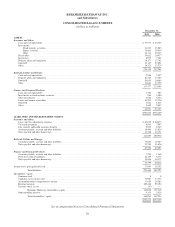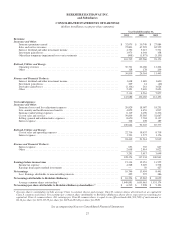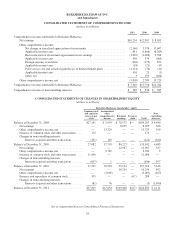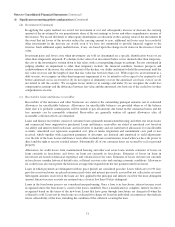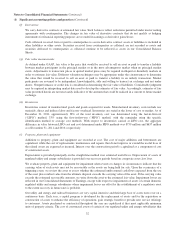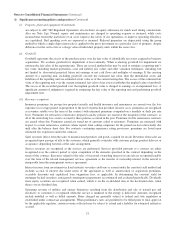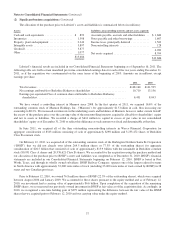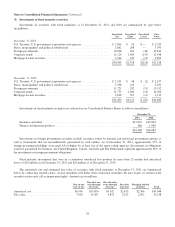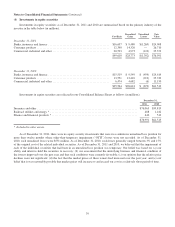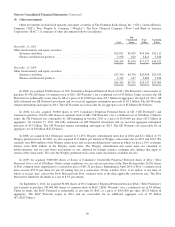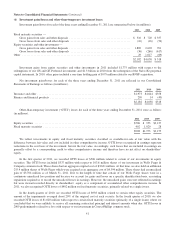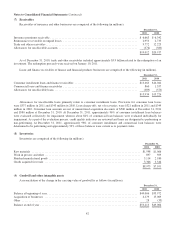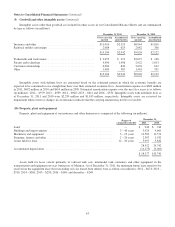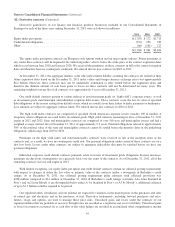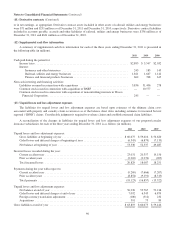Berkshire Hathaway 2011 Annual Report Download - page 38
Download and view the complete annual report
Please find page 38 of the 2011 Berkshire Hathaway annual report below. You can navigate through the pages in the report by either clicking on the pages listed below, or by using the keyword search tool below to find specific information within the annual report.Notes to Consolidated Financial Statements (Continued)
(1) Significant accounting policies and practices (Continued)
(t) New accounting pronouncements (Continued)
In October 2010, the FASB issued ASU 2010-26, “Accounting for Costs Associated with Acquiring or Renewing
Insurance Contracts.” ASU 2010-26 modifies the types of costs that may be deferred in the acquiring or renewing of
insurance contracts. ASU 2010-26 specifies that only direct incremental costs related to successful efforts should be
capitalized. Capitalized costs include certain advertising costs which may be capitalized if the primary purpose of the
advertising is to elicit sales to customers who could be shown to have responded directly to the advertising and the
probable future revenues generated from the advertising are in excess of expected future costs to be incurred in
realizing those revenues. ASU 2010-26 is effective for Berkshire beginning January 1, 2012 and will be applied on a
prospective basis.
In May 2011, the FASB issued ASU 2011-04, “Amendments to Achieve Common Fair Value Measurement and
Disclosure Requirements in U.S. GAAP and IFRSs.” The amendments in ASU 2011-04 clarify the intent of the
application of existing fair value measurement and disclosure requirements, as well as change certain measurement
requirements and disclosures. ASU 2011-04 is effective for Berkshire beginning January 1, 2012 and will be applied
on a prospective basis.
In June 2011, the FASB issued ASU 2011-05, “Presentation of Comprehensive Income.” ASU 2011-05 changes the
way other comprehensive income (“OCI”) is presented within the financial statements. Financial statements will be
required to reflect net income, OCI and total comprehensive income in one continuous statement or in two separate
but consecutive statements. The accompanying Consolidated Financial Statements show net earnings, OCI and total
comprehensive income in two separate, but consecutive statements. In December 2011, the FASB issued ASU
2011-12 that deferred the provisions of ASU 2011-05 relating to the requirement to report reclassification adjustments
between OCI and net earnings in the statements of earnings.
In September 2011, the FASB issued ASU 2011-08, “Testing Goodwill for Impairment.” ASU 2011-08 allows an
entity to first assess qualitative factors in determining whether it is necessary to perform the two-step quantitative
goodwill impairment test. Only if an entity determines that it is more likely than not that the fair value of a reporting
unit is less than its carrying amount based on qualitative factors, would it be required to then perform the first step of
the two-step quantitative goodwill impairment test. ASU 2011-08 is effective for and will be applied by Berkshire
beginning January 1, 2012.
In December 2011, the FASB issued ASU 2011-11 “Disclosures about Offsetting Assets and Liabilities.” ASU
2011-11 enhances disclosures surrounding offsetting (netting) assets and liabilities. The standard applies to financial
instruments and derivatives and requires companies to disclose both gross and net information about instruments and
transactions eligible for offset in the statement of financial position and instruments and transactions subject to a
master netting arrangement. ASU 2011-11 is effective retrospectively for Berkshire beginning January 1, 2013. We
are still evaluating the effect this standard will have on our Consolidated Financial Statements.
Except as otherwise disclosed, we do not believe that the adoption of these new pronouncements will have a material
effect on our Consolidated Financial Statements.
(2) Significant business acquisitions
Our long-held acquisition strategy is to purchase businesses with consistent earning power, good returns on equity and able
and honest management at sensible prices.
On March 13, 2011, Berkshire and The Lubrizol Corporation (“Lubrizol”) entered into a merger agreement, whereby
Berkshire would acquire all of the outstanding shares of Lubrizol common stock for cash of $135 per share (approximately $8.7
billion in the aggregate). The merger was completed on September 16, 2011. Lubrizol, based in Cleveland, Ohio, is an
innovative specialty chemical company that produces and supplies technologies to customers in the global transportation,
industrial and consumer markets. These technologies include additives for engine oils, other transportation-related fluids and
industrial lubricants, as well as additives for gasoline and diesel fuel. In addition, Lubrizol makes ingredients and additives for
personal care products and pharmaceuticals; specialty materials, including plastics; and performance coatings. Lubrizol’s
industry-leading technologies in additives, ingredients and compounds enhance the quality, performance and value of
customers’ products, while reducing their environmental impact.
36


